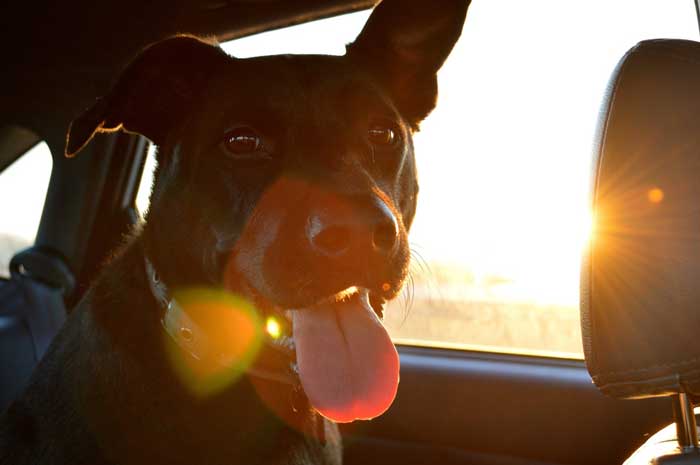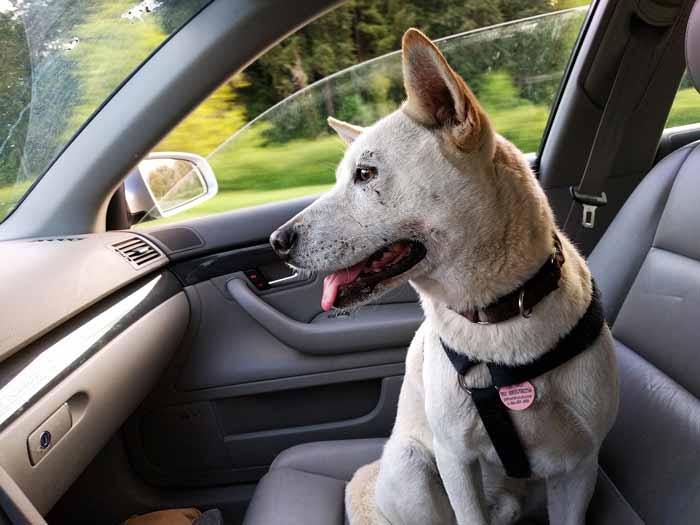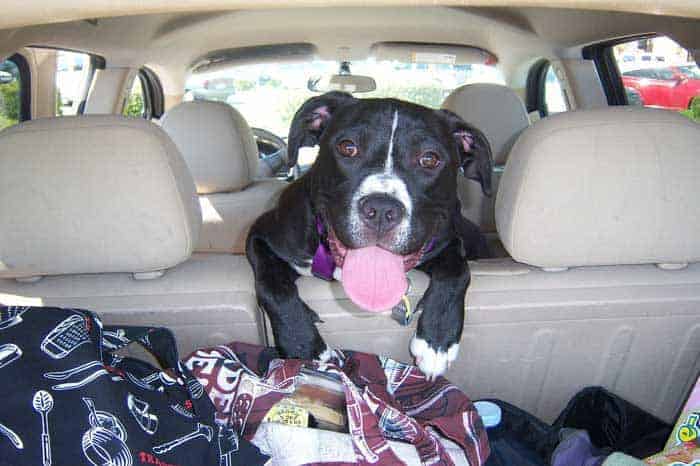Panting is a very common dog behavior. Mainly, dogs pant when they are hot and need to cool off and regulate their body temperature.
But when your dog pants in the car, there may be other reasons behind the behavior. It’s important to recognize the reasons behind why do dogs pant in the car so that we can know when our dog may need help.
5 Common Reasons Dogs Pant in the Car
The most common reasons why dogs pant in the car are:
To Cool Down Body Temperature
The main reason why dogs pant is to regulate their body temperature.
Humans sweat to cool down our bodies, but dogs cannot do it because of their fur. They only sweat through their paws, but it’s not enough.
By panting, dogs take the hot air out of their lungs and replace it with fresh air from outside, triggering a physiological process that allows them to regulate their body temperature.
For this reason, dogs often pant after an exercise session or in hot weather.
The temperature inside a car is usually higher than outside, especially in summer, so your pet can easily get hot and pant to cool off.
Dogs begin to pant even when they feel a little hot. But the hotter they are, the more intense the panting will be.
Heatstroke in dogs is something to be taken seriously and every effort must be made to prevent it. This happens often when a dog is left inside a hot car.
When a dog suffers from heatstroke, he breathes heavily and pants excessively, among other symptoms.
Sign of Happiness
Panting can be a sign of a happy dog.
When your dog starts panting as soon as he gets into the car, he is relaxed and his body language shows signs of happiness such as wagging his tail, this means that he is excited and happy.
When a dog associates a car ride with positive things, such as a trip to the countryside or a park, it will be excited by the adventures that await him.
Anxiety
It is common for some dogs to feel anxious when riding in the car. Some of the reasons a dog may be afraid of traveling in a car are:
- A negative experience. A dog can relate car travel to scary things like going to the vet or other negative experiences he has had in the past.
- A new and unfamiliar experience. Traveling by car is full of new smells, sounds and sensations that can be an overwhelming and stressful experience for a dog.
When a dog is in a stressful situation and feels anxious, he will feel an increase in his body temperature. Panting helps a dog calm down and handle stress and anxiety better.
Pain or Discomfort
Panting can be a sign that a dog is in pain or has some type of discomfort. Panting is commonly one of the first signs that a dog is feeling bad.
When a dog pants in a car it may be a sign of car sickness. Due to the movement of the car, many dogs may feel dizzy, nauseous, and even vomit.
Other Causes to Consider
There are other possible reasons why your dog is panting in the car.
If you suspect that your pet suffers from some of these conditions, it’s necessary to seek help from a vet immediately.
- Obesity. It is common for obese dogs to have shortness of breath among other health problems. A sign of this is excessive and heavy panting.
- Drug Reaction. Some medications can increase the frequency of breathing or cause excessive panting.
- Allergies. When a dog experiences an allergy, it may pant heavily if has trouble breathing well.
- Poisoning. Abnormal panting can be a sign of poisoning.
- Heart Issues. Dogs with heart problems can pant heavily and constantly as they have trouble catching their breath.
Dealing With Your Dog’s Anxiety in Cars

Why Do Dogs Get Anxious in Cars?
A dog can suffer from anxiety in a car for various reasons.
Some dogs are not used to traveling by car. Traveling by car is full of new and diverse sensations, sounds, and smells that can be very overwhelming and confusing for a dog, especially the first few times.
Other dogs come to associate a car ride with something negative. This is common to happen when the dog only travels by car to go to the vet or some other place that relates to something he doesn’t like.
Some symptoms of car anxiety, also known as travel anxiety, can range from mild to severe. The most commons are:
- Panting
- Shaking
- Salivation
- Vomiting
- Urination
How Can I Calm My Dog’s Anxiety in the Car?
Anxiety is not overcome overnight. It takes time and dedication.
When your dog’s anxiety is not severe, it can be overcome with short trips and positive associations. This works best with puppies, although it can also help adult dogs.
The goal is for him to start associating the car with things he enjoys.
Start by taking short trips with your dog to places that are fun for him. They can be car rides to the dog park, to the beach, etc. Gradually, your dog will build good and positive associations with riding in the car.
In severe cases of anxiety, it is recommended to seek the help of a professional animal behaviorist or a dog trainer.
Dealing With Dog’s Car Sickness
Car Sickness in Dogs
Motion sickness is more common in puppies than in adult dogs. This is because in puppies the ear structures used for balance are not fully developed.
But this does not mean that adult dogs do not suffer from car sickness. If a dog was nauseous and even vomited on his first car rides, he may have been conditioned to feeling nauseous and sick when riding by car.
This can happen even when the structures of the dog ears are already fully developed and mature.
Some signs of motion sickness in a dog are:
- Excessive panting
- Yawning
- Whining
- Excessive drooling
- Vomiting
How to Prevent Dog Motion Sickness
The best way to help a dog and prevent motion sickness is to make car rides as comfortable as possible.
Some tips that can help you are:
- To prevent your dog from being nauseous make sure that he is facing forward. There are dog seat belts and harnesses that are of great help for this.
- Having the window down a couple of inches helps balance the air pressure inside the car with the pressure outside. This helps reduce your dog’s discomfort and nausea.
- Keeping the car cool and ventilated helps prevent your pet from feeling uncomfortable.
- Limiting what your pet eats before car rides can help prevent him from feeling sick.
How to Keep a Dog Comfortable and Safe in the Car

Check Your Dog’s Health Regularly
Our dog needs to be checked regularly by a vet. Panting can be a sign of an illness or pain that our dog is having.
Watch out for the Temperature
You should never leave your dog inside a hot car, even if the windows are half-open. The temperature inside a car can rise dangerously in a matter of minutes.
We always have to take care of the temperature inside our car to avoid that our dog suffers from dehydration or a heatstroke.
Provide Water
When you travel with your dog in a car, especially on long car rides, always carry fresh water with you so he doesn’t get dehydrated.
Provide New Experiences
Since puppyhood, it is necessary to help him build his confidence and handle situations that could stress him.
For this, we must provide our dog with new experiences regularly, and make him familiar with a variety of things, such as new smells, sounds and people.
Always in the Back Seat
For the safety of your dog and yours, it’s recommended to always make sure that your dog sits in the back seat.
If your dog is in the front seat, especially if he is not restricted, it can be a great distraction. Also, if there is an accident, he can be seriously injured by the safety bag.
Restrain your Dog
In addition to being safer, many dogs feel calmer and more comfortable when restrain in the car.
When restrained, you avoid your dog to be injury from a sudden movement of the car. Even if a pet is thrown from the seat by a movement of the car, it can cause him to develop anxiety in the car.
Likewise, distractions and problems such as your dog walking around the car or jumping on you while driving can be avoided.
To restrict your pet in the car you can use:
- Dog harness
- Travel carrier
- Dog crate
Final Thoughts
Dog panting in a car is a natural behavior and is generally not a cause for concern.
As responsible dog owners, we must be careful and observe the overall behavior of our dog. This will allow us to know if the panting of our dog is normal or not, in order to help him.
Resources
- Dogs and Motion Sickness by Pet WebMD
- How to Relieve Dog Travel Anxiety by PetMD

